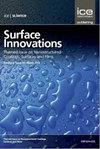Towards tailored surface topography on electrospun wound dressings for maximised exudate absorption
IF 3.5
4区 材料科学
Q3 CHEMISTRY, PHYSICAL
引用次数: 0
Abstract
Since electrospinning can generate micro- to nanometre-scale fibres, it is widely used for fabricating wound dressings. Electrospun scaffolds with defined three-dimensional patterns at the mat surface can be efficiently fabricated using textured collectors that transfer the topography during the manufacturing process. However, the efficacy of surface pattern transfer from the collector to the mat, the correlation between the topography and the absorption capability and the effect of sterilisation on absorption have not yet been analysed. In this study, textured patterns were imprinted over polycaprolactone electrospun mats using textured collectors. The successful transferability of the patterns was quantified through height, hybrid and functional surface topography parameters. Additionally, ethylene oxide, hydrogen peroxide (H 2 O 2 ) and ultraviolet (UV) sterilisation methods were tested, of which only UV preserved the morphological and functional integrity of the mat. Finally, fibroblasts were used to analyse the cytotoxicity and cellular response of the dressings, verifying their biocompatible nature. This study demonstrates that absorption capacity can be modulated by the surface texture of the wound dressing. The S dq and S dr parameters were identified as key surface characteristics for enhancing absorption capacity and yielded an increase of up to 176.76% compared with the non-textured control, thus revealing the potential of surface functionalisation for increasing exudate absorption.为了最大限度地吸收渗出液,定制了静电纺伤口敷料的表面形貌
由于静电纺丝可以产生微到纳米级的纤维,它被广泛用于制造伤口敷料。利用在制造过程中传递地形的纹理收集器,可以有效地制造出具有明确三维图案的静电纺丝支架。然而,表面图案从收集器转移到垫子的有效性,地形与吸收能力之间的相关性以及灭菌对吸收的影响尚未得到分析。在这项研究中,利用纹理收集器在聚己内酯静电纺垫子上刻印纹理图案。通过高度、混合和功能表面形貌参数量化了模式的成功转移性。此外,对环氧乙烷、过氧化氢(h2o2)和紫外线(UV)消毒方法进行了测试,其中只有紫外线能保持绷带的形态和功能完整性。最后,用成纤维细胞分析敷料的细胞毒性和细胞反应,验证其生物相容性。这项研究表明,吸收能力可以通过伤口敷料的表面质地来调节。sdq和sdr参数被确定为增强吸收能力的关键表面特征,与非纹理控制相比,其吸收能力增加了176.76%,从而揭示了表面功能化增加渗出物吸收的潜力。
本文章由计算机程序翻译,如有差异,请以英文原文为准。
求助全文
约1分钟内获得全文
求助全文
来源期刊

Surface Innovations
CHEMISTRY, PHYSICALMATERIALS SCIENCE, COAT-MATERIALS SCIENCE, COATINGS & FILMS
CiteScore
5.80
自引率
22.90%
发文量
66
期刊介绍:
The material innovations on surfaces, combined with understanding and manipulation of physics and chemistry of functional surfaces and coatings, have exploded in the past decade at an incredibly rapid pace.
Superhydrophobicity, superhydrophlicity, self-cleaning, self-healing, anti-fouling, anti-bacterial, etc., have become important fundamental topics of surface science research community driven by curiosity of physics, chemistry, and biology of interaction phenomenon at surfaces and their enormous potential in practical applications. Materials having controlled-functionality surfaces and coatings are important to the manufacturing of new products for environmental control, liquid manipulation, nanotechnological advances, biomedical engineering, pharmacy, biotechnology, and many others, and are part of the most promising technological innovations of the twenty-first century.
 求助内容:
求助内容: 应助结果提醒方式:
应助结果提醒方式:


